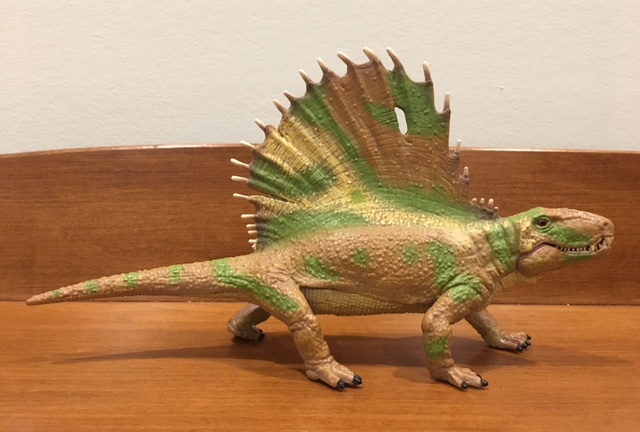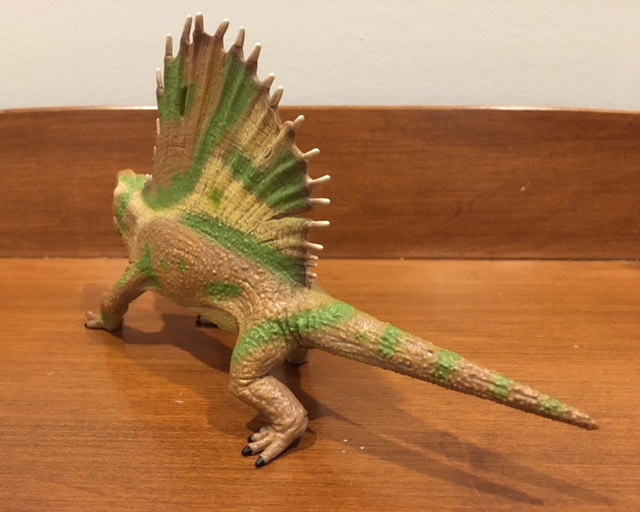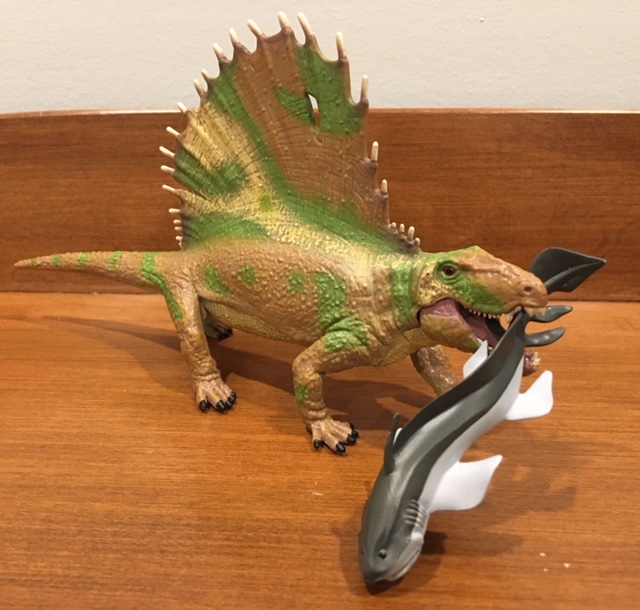For hours, Thorn has been wandering along the banks in search of a meal. Now, at long last, her eye catches sight of a telltale movement in the murky water. Immediately, she plunges into the river and sinks her teeth into the unsuspecting shark’s flesh. The shark retaliates with a vicious bite of its own, but Thorn ignores the pain and hauls her victim out onto dry land. She clamps her jaws down even harder, and with a final shudder, the shark is dead. Thorn’s patience and toughness have paid off . . .

Dimetrodon is by far the most famous synapsid due to its regular inclusion in countless prehistoric books and toylines, to the point where it is often considered an “honorary dinosaur” despite the fact that it was more closely related to mammals like us. Fittingly then, it is one of CollectA’s first two synapsid figures, the other being an Estemmenosuchus. Unlike many previous Dimetrodon toys, which are sculpted in a lizard-like stance with their legs sprawled out to the sides, this one is walking tall and proud with its tail and belly held well off the ground. This is in keeping with fossil trackways which indicate an animal that did not drag its belly or its tail along the ground. From the tip of its snout to the end of its tail, the Dimetrodon measures a good 19.5 cm long and is slightly over 11 cm high at the top of its sail.

The Dimetrodon‘s main colour is light brown with a beige underbelly. Light green markings adorn the head, body, and tail, along with waves of beige on both sides of the sail. The eyes are reddish brown with black pupils, the teeth are white, the inside of the mouth is dull pink, and the claws are black. To top it all off (literally), the tips of the neural spines making up the sail are bone white, as though they were sheathed in keratin. As explained in this article by paleontologist and ace skeletal illustrator Scott Hartman, this newer, pricklier appearance is based on recent studies of Dimetrodon fossils which found that the tips of the vertebrae forming the sail are often bent, sometimes severely. Moreover, the texture of the neural spines varies from rough where they would be encased in back muscles, to one consistent with being within a sail, and to smooth at the top where they would have stuck out of the sail. Hence this Dimetrodon‘s ragged-looking sail, which provoked the name Thorn.

If you read the entire article I linked to in the previous paragraph, you’re aware that Dimetrodon appears to have had a distinct curvature in its spine just before the hips. Thorn here does have such a curve in her back, although it doesn’t look quite as pronounced as the one in the skeletal illustration. Or maybe that’s simply the result of bones being covered in muscle and skin. Her skin is a combination of wrinkles and bumps while her underbelly is covered in small, fine scutes. The precise nature of synapsid skin has been an ongoing topic of debate, but Ascendonanus nestleri, a very recently described basal synapsid, shows traces of scales. Thus Thorn’s skin can be considered realistic for now. I do wish she had lips covering more of her teeth though.

Thorn’s legs are small but muscular, like those on a Komodo dragon. Her claws are small and her feet boast the correct number of digits (five on each). The neural spines comprising her sail can be clearly seen and felt beneath the skin. There’s also a sizable cleft in her sail at the back, and a gaping hole near the front. Looks like Thorn has been through her share of scrapes over the course of her life. The Permian was a time of few herbivores and many carnivores, so competition over food and territory must have been pretty brutal.

Like many of CollectA’s recent prehistoric carnivore figures, Thorn has a hinged jaw for increased play or display value, or both if you prefer. A Dimetrodon‘s main weapon was its deadly array of large and small teeth, and that dentition is well reflected here. You can easily make out the large incisors at the front, the even larger caniniformes in the upper jaw, and the smaller rows of teeth at the back of the mouth. Whereas smaller, earlier species of Dimetrodon had smooth teeth, the larger, later species like D. grandis had serrated teeth that were also bigger in proportion to their owners’ size. This would have allowed them the evolutionary advantage of taking on bigger, more dangerous prey. An apex predator like Dimetrodon would have readily gone after land animals like Edaphosaurus and Seymouria, but it has recently been proposed that its primary diet consisted of fish. Specifically, freshwater sharks such as Xenacanthus and Orthacanthus, which were vicious predators in their own right. Their fossils have been found intermingled with those of Dimetrodon, indicating that savage and desperate battles such as the one in my introduction regularly took place in the streams and rivers of Permian North America.

Eat your heart out, Spinosaurus!
The CollectA Dimetrodon is daring, dynamic, and definitely worth adding to your collection. For myself, it’s now my favourite rendition of the genus. Can’t wait to get my hands on the Estemmenosuchus as well. And as I mentioned before in my Dunkleosteus review, I certainly hope that CollectA gives us more Paleozoic critters in the future. An Edaphosaurus or a Cotylorhynchus or both would go perfectly with Thorn!

Many thanks to CollectA for this preview sample! The Dimetrodon will be available in online stores this June!
Support the Dinosaur Toy Blog by making dino-purchases through these links to Ebay and Amazon. Disclaimer: links to Ebay.com and Amazon.com on the Dinosaur Toy Blog are often affiliate links, when you make purchases through these links we may make a commission

An odd year for “the big four” (Safari, CollectA, Papo & Schleich) duplicating figures. We usually get one or two competing sculpts, but this year we get 2 Tyrannosaurus’, 2 Triceratops’, 2 Therizinosaurus’, 2 Amargasaurus’, 2 Iguanodons and 2 Dimetrodons.
Can’t be all that good for business.
Maybe they should start comparing notes or perhaps just pick blindly from the same hat.
On a scale of 1 to 10, how would you guarantee scientific accuracy?
Great sculp and I also like the colors, but it has that highly toy-like look, which is usual for Collecta except for the Iguanodon.
To be fair, Collecta figures are meant to be toys.
Great figure… looks way more mamallian than the Safari, which in itself is a great figure too, but a bit too conservative in my opinion. Bit off putting for me is the size of the figure – and the military camo, but that could easily be helped.
Conservative in what way? As in too reptilian?
I find the color scheme on this one extremely off-putting and implausible, but as you say, paint can fix that.
The dimetrodon of Collecta the only defect that I find is that you notice a lot the seams of the jaw. On the other hand it is a very good outstanding figure pulling according to my opinion to the registration of honor, his sculpture is good, what perhaps spoils him is his painting as members of the camouflage type forum have commented.
That does not mean that it rival in genius with that of other companies like Safari, I do not know which of the two is better.
I couldn’t care less about which is better. They’re both splendid toys.
I totally agree with you Suspsy each of them is great following his own license or artistic freedom, of course, as are the rest of the companies mentioned here.
That is the reason why I do not say which of them seems better or worse since all comparison is odious. It’s like comparing the paleoartistic works of an artist like Luis Rey with John Sibbick for putting two examples each one is great in its own way and we may like it more or less.
To be honest I like all the versions exposed in the forum dimetrodon even if there are brands that use a retro version, each has its charm.
Summing up the version of the dimetrodon of Collecta is gorgeus and very cool apart from that it is very cool.